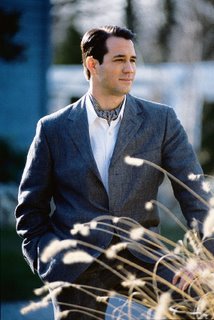Mrs. P&C and a Seersucker suit...
 Cool, comfortable, easy to care for, and genuinely classic, seersucker epitomizes what warm-weather clothing should be. With so many redeeming qualities, it is difficult to understand how the fabric has struggled for survival.
Cool, comfortable, easy to care for, and genuinely classic, seersucker epitomizes what warm-weather clothing should be. With so many redeeming qualities, it is difficult to understand how the fabric has struggled for survival. From the Hindi word sirsaker, which is literally translated as milk and sugar, seersucker first became popular when it was used for silk pajamas and nightshirts worn by the British Raj in India. The fabrics crinkly texture results from the various slackening processes that the threads undergo during weaving. Indian weavers referred to these cloths as homespun, and much pride went into the handwork.
The cotton seersucker suit as we know it first surfaced in New Orleans at the turn of the 19th century and quickly became the suit of choice for wealthy Southern plantation owners. Unopposed to the wrinkles, these gentlemen were no doubt attracted to the fabrics light weight, as well as the meager $10 price tag for a complete suit.
However, among Northerners, save for a smattering of style-conscious Princetonians, the seersucker suit was mostly regarded with snobbish disdain, particularly by New Yorkers unwilling to sacrifice a crisp crease for comfort. Above the Mason-Dixon Line, seersucker was shrugged off as a poor mans fabric better left to the South.
As the 1940s unfolded, the seersucker suit, oddly enough, began to win favor along the northeastern seaboard, even becoming something of a status symbol in such stalwart business cities as Washington, D.C., and New York. During the early 1950s, an industrious New Orleans clothier named Joseph Haspel developed a seersucker suit that could be washed and worn without pressing. Haspel blended polyester and cotton to create a seersucker cloth that retained its shape even after rigorous machine washings. A showman by nature, Haspel demonstrated his fabric breakthrough at a Florida convention of tailored clothing buyers. He called a press conference on a beach and, as the story goes, walked into the ocean up to his neck wearing one of his new suits. Later that evening, Haspel wore the same suit, silencing even the most seasoned cynics. Wrinkle-resistant seersucker was born, and Haspel would forever be known as the father of the washable seersucker suit.
Hollywood soon lent its influence in promoting seersucker as a stylish suit fabric. Who could forget the derring-do of James Cagney in A Lion in the Streets or the cool nonchalance of Tom Ewell in The Seven Year Itch. Gregory Peck, at his forthright best in To Kill a Mockingbird, entered the courtroom clad in a seersucker suit replete with wrinkles.
The newest look in seersucker jackets is the high-roll, three-button, single-breasted model. Yet double-breasted, peaked-lapel versions with either four or six buttons are still very popular.
While blue and white remains the classic color combination, many designers are offering seersucker in more unusual shades that evoke another era pale gray, ecru, and dusty rose, for example.
The contemporary seersucker suit always looks appropriate with a simple bow tie and would not be complete without a jaunty pocket square of linen or cotton peeking out from the breast pocket. But a more modern way to wear it would be sans tie with a white or pale-colored cotton T-shirt. We can't think of anything cooler for the dog days. - Ralph DiGennaro
<< Home